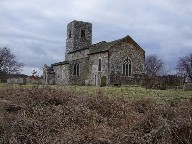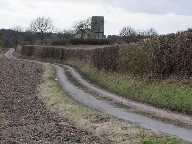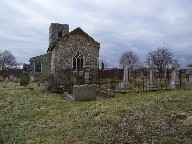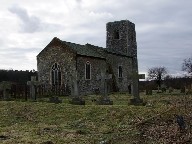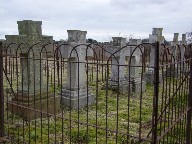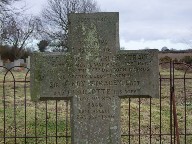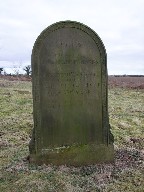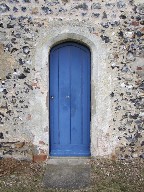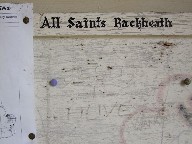| |
|
All
Saints, Rackheath
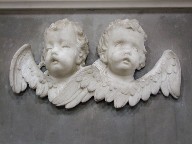 |
|
It
did not help that I came here on one of the
gloomiest, coldest days of February 2009, but
this must always seem a remote spot. And yet, it
is rather a charming one. All Saints was declared
redundant long ago, back in the 1970s, and that
should be no surprise. This is a huge parish, and
the main village it serves is more than a mile
off. The opening of a modern chapel of ease there
must have sounded the death knell for All Saints. Now, the
liturgical life of this building is over, and the
silence fills its days out here in what feels
like the middle of nowhere. In fact, we are
barely three miles from the outer edge of Norwich
suburbia, but you wouldn't know it. This lonely
little church sits on its bluff above the fields,
with only its gravestones for company, reached by
a narrow track along the edge of a field, which
peters out as it reaches the church gate.
|
And all
around the woods and fields roll, the gently hilly
landscape of the country above the winding rivers of the
Broads. The church does not seem an intrusion in this
landscape. Rather, there is something entirely organic
about it, as if it has grown from the land it serves, or
as if has been left here for us to find by a former
civilisation; which is nearly true, of course. Thanks to
the sterling work of the Norfolk Churches Trust, this
church is open all day, every day, when most around here
are not.
This must
be an ancient site. Ridges in the adjacent fields show
that there was a settlement here, probably until well
into the 19th Century, but now everybody lives down on
the other side of the Norwich to Wroxham road. Rackheath
Hall was home to first the Pettus family and then the
Straceys, and above all else this church is their
mausoleum. The first sign of this is in the graveyard,
where the Straceys' sombre matching crosses stand, fenced
off still, to the east of the church.
Nothing
much happened here in the way of building work in the
late Middle Ages, and what you see today is pretty much
all of the Decorated period. The south aisle is rather
curious, because the roofline cuts into the clerestory,
suggesting that it may have been refashioned after
medieval times, possibly to serve as a memorial aisle for
the Pettus family.
You step
into a building which is full of light, thanks to the
clear glass in the aisle and east window. Everything is
white and clean; and, ironically, it all feels
beautifully cared for. There were large displays of red
flowers decorating the font and windowsills when I came
here on a cold February day. The interior was spotless,
unlike that of several working churches which I had
visited earlier in the day. It was breathtakingly cold,
and the great expanses of wall memorials in the aisle and
on the north side of the nave really made it feel as if
this might be the mausoleum of a lost civilisation.
The Pettus
memorials are elegant and lovely, and surprisingly grand
in such an outpost, although they also serve as a
reminder that, until barely three hundred years ago, if
we had been here we would have found ourselves just
outside the second city of the Kingdom. The most striking
is to Thomas Pettus, who in 1723 was taken from the
tender embraces of his most indulgent parents that he
might receive the rewards promised in another life to a
most engaging friendly behaviour, a most strict and
filial obedience, a most sincere, regular and early piety
in this. From a quarter of a century earlier, but
looking the work of another quarter of a century before
that, the bold memorial to Thomas Pettus's grandfather is
a rather more serious and sombre proposition.
The
Stracey memorials are more workaday, and form a kind of
catalogue, one of the most complete records in stone of a
Norfolk family's fortunes over the ups and downs of
several centuries. Probably the most beautiful is a 1930s
monument to Mary Elizabeth Brinkley, in that flowery
development of Jazz Modern which was popular at the time,
possibly as a kitschy reaction to the severe lines of
cinemas and public buildings of the age. Noting that she
was a great-great-grand-daughter of Richard Brinsley
Sheridan, it concludes with an equally flowery
epitaph, which observes in part that from out of the
murk and mistiness of life her dreams arise, most cool
and delicate, and circle her like white and azure
flowers. This is credited to Eleanour Norton, an
obscure poet best known for the mawkish Enshrine Thy
Youth, which was popular in the years leading up to
the First World War.
Finally,
several 20th Century brasses recall the familiar
heartbreak of this intensely rural parish. Horace Arthur
Symonds of Hall Farm, Rackheath, died of his wounds
on March 3rd 1916, and is buried at Etaples near Le
Touquet in northern France. The Saints of God! Their
conflict past, and Life's Long Battle won at last, no
more they need the shield or sword, and cast them down
before the Lord. The epitaph is curiously
militiaristic, suggesting that the memorial was erected
while the conflict is still in progress, and before the
reflectiveness which followed the Armistice.
| Rather
more prosaic, and more moving because of it, are
two brass plaques by the south doorway. The first
is that to Herbert John Harmer, who died in
October 1916, and Robert James Charlish, who died
in July 1917. They were both just twenty years
old. This Monument is erected by Mr Stephen
Sutton their former employer, reads the
inscription. England Stands for Honour, God
Defend the Right. Beneath it
you'll find eleven year old Muriel FJ
Bidwell, Chorister of this church who was
mortally injured by a motor car, and entered
Paradise 10th December 1925. I knew to look
for this because earlier in the day, at another
church, I had met an old man who had grown up in
Rackheath. As an infant, he had attended Muriel
Bidwell's funeral. She had been playing in a
puddle at a corner in the road, and the car had
skidded and crushed her. The lesson of this had
obviously been made very plain to the children of
Rackheath at the time, and now in his late
eighties he had never forgotten it.
|
|
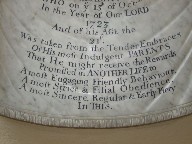 |
|
|
|

